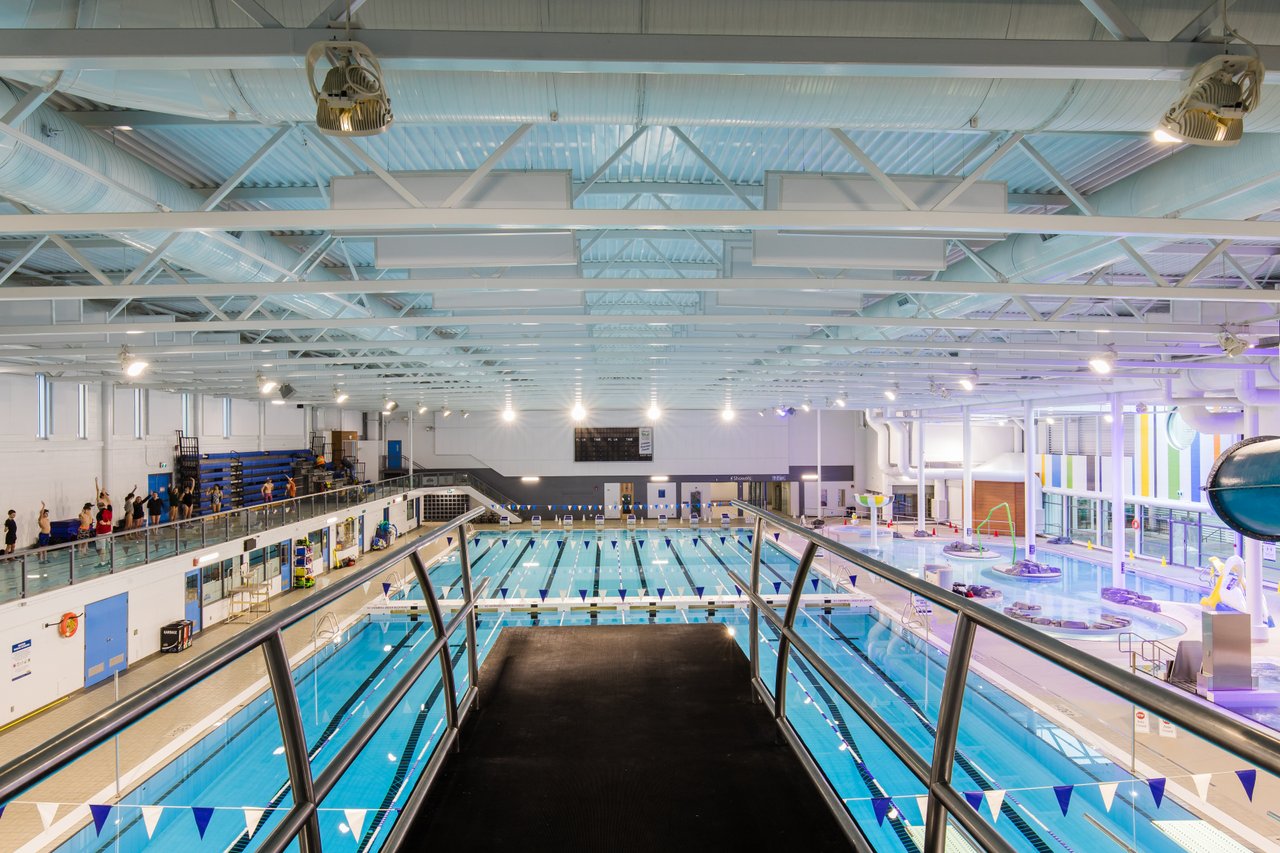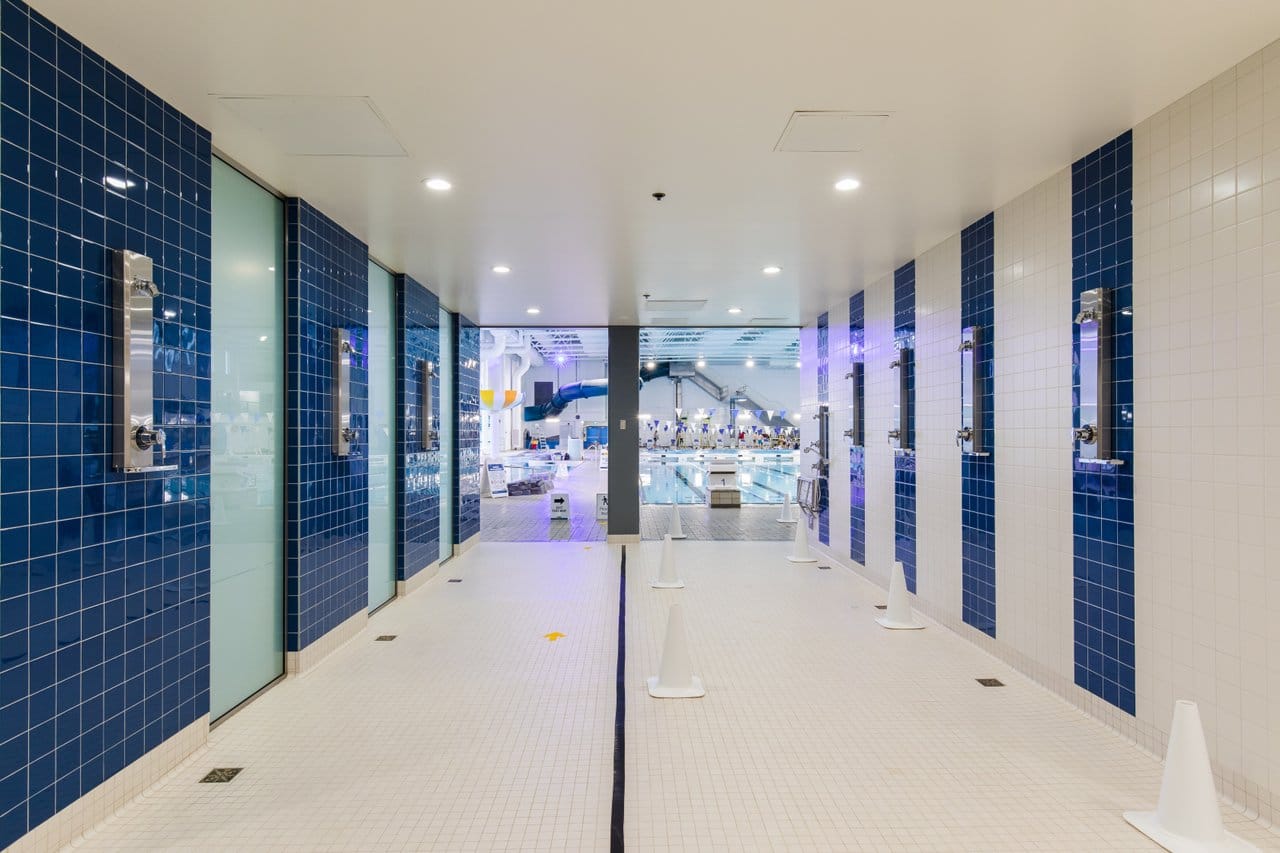The Canada Games Aquatic Center (CGAC) was the first signed and completed Integrated Project Delivery (IPD) agreement in British Columbia. The project consisted of renovating and upgrading the City's main indoor pool, located at 910 McGill Road in Kamloops. The facility was originally constructed for the 1993 Canada Summer Games and is now described as the busiest site within the municipal boundaries, with more than 2,000 users per day.
Investigating Factors Leading to IPD Project Success in Canada is a new research report including three IPD case studies. It was co-authored by Ahmad Arar, M.Sc., PhD Candidate, and Prof. Erik Poirier, PhD, from the Ecole de Technologie Supérieure, Montreal, Canada. Further members of the research team included Prof. Sheryl Staub-French, PhD, Adjunct Prof. Puyan Zadeh, PhD, and PhD Candidate Devarsh Bhonde, MTech.
Project at a Glance
Building Type: Sports & Recreation
Project Type: Modernization
Location: Kamloops, BC
Building Size: 34,000 sqft
Budget: $14,142,000
Schedule: 7 months Design, 8 months construction
Owner: City of Kamloops
Architect: Group2
Contractor: Chandos
Project Start: March 2019
Completion: December 2020

Source: City of Kamloops, Photographer: Kathleen Fisher
THE CHALLENGES
Over its 26 years of service, the CGAC was maintained, but never upgraded. The existing building envelope, as well as the mechanical and electrical systems, showed signs of fatigue and were nearing or beyond the end of their expected service life. In addition, the CGAC has been responsible for a significant portion of Kamloops’s greenhouse gas (GHG) emissions.
Therefore, the project’s main objectives were to
- Upgrade the facility
- Increase overall building durability with an innovative envelope and mechanical solutions
- Reduce energy use, and
- Reduce greenhouse gas (GHG) emissions.
Frustration with traditional delivery models
The frustration with the outcomes of the city’s previous projects using traditional delivery models, such as design-bid-build, design-build, and construction management, motivated them to try a different approach. As the owner stated: “We had a bunch of bad experiences with some traditional delivery models, despite us doing everything by the book, and everything exactly how we were supposed to do it, and to see things still fail.”
Developing the contract
From the owner’s perspective, adopting the IPD contract presented several challenges. First, being a municipal government body, its role and responsibilities demanded that it ensure compliance with regulatory and procurement requirements.
In addition, the project included a liability waiver across all signatories, which was a point of agreement among the team members and the owner, who aimed to guarantee a fair procurement and contract process in such a way as to avoid pushing risk onto the other project parties.
The owner believed that a critical advantage of IPD lies in its not focusing on where to distribute the blame, but rather on how to find solutions as a team, benefiting the project. “Construction is complicated, and the blame gets distributed in different ways. To decide upfront that, this is how blame is going to be distributed, was not very IPD.”
Clarity and communication of goals
The team set two types of goals:
- Hard goals involved measurable objectives, such as, on time, on budget, safety, and reduction of greenhouse gas emissions and energy consumption.
- Soft goals included team values and the owner’s conditions of satisfaction.
Goals for team values: having fun, collaborative culture, knowledge sharing.
Owner’s conditions of satisfaction goals: sustainability, accessibility, maintained operation during construction, facility revitalization, best utilization of space, and a welcoming place for visitors and users.
The team members felt that it was crucial to communicate the project goals effectively because this delivery system involves very different practices and environments than traditional delivery models. “We need to do better to communicate what we are doing, why we are doing it because it is so much different than what people are used to.”
Team selection
Due to past unpleasant experiences involving the low bid tender strategy, the owner of the CGAC switched RFP strategies not only for IPD projects but for all the other project delivery systems. As a result, they now adopt a “best value" approach in all their RFPs.
Lack of IPD experience
The poly party members described their team as forming a new entity for whom the success and failure of the project depended on the joint efforts of all team members. Several team members, particularly the trade partners based in Kamloops, lacked experience in IPD. In this regard, team members with previous IPD experience provided advantages, such as their ability to assist the rest of the team throughout the process.

Source: City of Kamloops, Photographer: Kathleen Fisher
THE SOLUTION
Several factors played a role in the decision to adopt IPD for the CGAC project, namely
- The project characteristics
- Dissatisfaction with previous project outcomes that used traditional delivery methods
- The potential benefits of IPD.
Third party facilitator
The owner's approach to project facilitation was to hire a neutral third-party facilitator. They were not a signatory to the IPD agreement, and their duty was primarily to give expertise and guidance to the team on the various processes and phases of IPD.
Since the team members had different levels of experience with IPD, and for some, it was their first IPD project, the third party facilitator acted as an advisor for the contract negotiation process. He helped clarify different aspects of the contract and ensured that all parties understood the contract.
The contract used in the CGAC project was the Hanson Bridgett IPD agreement. The contract negotiation took place during the validation phase, and it was signed right after validation. The owner started the process by including a template of the Hanson Bridgett IPD agreement in the RFP documents. The aim was to make RFP bidders aware of and prepared for the contract's various circumstances prior to submitting their proposals.
Team selection & waterfall RFP strategy
For the CGAC, the ‘best value’ approach helped create a team of people who brought the best value to the project.
Once the architect and the general contractor joined the team, they worked with the owner to determine who should be a partner and evaluate the RFP submissions. The hiring process continued with the engineering firms and trades until all the team members were selected. As the process progressed, when a member was selected, they were included in subsequent interviews.
A key feature of the RFP is that it is open for discussion, giving the opportunity to negotiate, question, and clarify any aspect of the proposal. This aspect was greatly appreciated by the team.
The evaluation criteria focused on the team members’ readiness and willingness to collaborate. As stated by one respondent, “We’ve had them do exercises that are not typical of interviews to allow us as interviewers, to see how they participate as a team doing a difficult exercise, solving puzzles, or engaging in a specific activity.”
Developing the parties & onboarding
The team members that lacked IPD experience strategically and proactively formed joint ventures with national trades who had IPD experience.
The onboarding sessions provided an opportunity to introduce the project team to Lean principles and tools from the beginning of the project. They tried to highlight the potential benefits, create buy-in among the project participants, and ensure engagement from the entire team. Many team members identified buy-in and team engagement as the cornerstone in the successful implementation of this approach.
The Project team
- Owner: City of Kamloops
- Architect: Group2 Architecture
- Structural Engineer: WSP Canada Inc.
- Building envelope Engineer: Entuitive Corporation
- Mechanical Engineer: Stantec Consulting Ltd.
- Electrical Engineer: WSP Canada Inc.
- General Contractor: Chandos Construction Ltd.
- Building Envelope Contractor: Western Roofing Master Roofers Ltd.
- Mechanical Contractor: Interior Plumbing and Heating Ltd.
- Electrical Contractor: AltaPro Electric Ltd.
Decision structure
The most important thing that made the decision structure work efficiently was setting the project goals and values early in the big room. A decision started by a discussion in the big room, to voice the team’s thoughts, then a vote was held with the project’s best interest in mind.

Image: City of Kamloops, Photographer: Kathleen Fisher
RESULTS
The high level of collaboration reached in the CGAC project reflected positively on many aspects of the project, such as accountability, problem-solving, fiscal transparency, and process efficiency.
As in most IPD projects, it was the team culture that made all the difference to the CGAC project. The team described their experience as follows: “We had fun, we were looking forward to seeing each other, we trusted each other, we made friends, we felt like a team, the best of my career, and I would prefer to do IPD for the rest of my career. A large part of the credit for this accomplishment is due to the team’s culture. “I really think that the social aspect of this project is largely what made it as successful.”
The project team expressed high satisfaction with the financial results of the CGAC project. They reported that 100% of their ICL was achieved. The project successfully obtained savings of $1 million out of $14 million budget, $700,000 of which consisted in the owner’s share of the incentive distribution formula, which was reinvested in the project to include several items from the Wishlist. Therefore, it can be stated that CGAC was completed on budget, and with more value for the owner.
KEY TAKEAWAYS
- IPD can be very effective for a project that is complex and has a high degree of unknowns.
- Contract workshops led by experts in the field can be helpful in ensuring all project team members have the same understanding of the various clauses in the contract and facilitate the contract negotiation process.
- The clarity of the owner’s goals in terms of the scope and available budget is crucial to ensuring a fully aligned team.
- Methods to communicate the project’s goals and values to the people on site and keep them engaged throughout the project must be determined from an early stage.
- A waterfall RFP strategy was employed is helpful in assembling the right team.
- The evaluation criteria focused on the team members’ readiness and willingness to collaborate and were tested through a series of questions and exercises performed during the evaluation process.
- The use of joint ventures for firms that lacked IPD experience was an effective way to accelerate learning and enable active participation in the IPD environment.
- Decision matrices are an effective tool to evaluate the pros and cons of a potential decision.
- A neutral third-party facilitator engaged by the owner provided expertise and guidance on various processes and phases of IPD.
- Lean concepts facilitated waste reduction in several aspects of the project by capitalizing on IPD’s collaborative teamwork approach.
- Collaboration is the central theme; its implication can be noticed in every part of the project which led to its success.
- Fun, partnership, trust, and a no-blame/ non-adversarial culture were some of the main attributes guiding the dynamics of the relationships on the project.
- The CGAC project was completed on budget and achieved 100% of the ICL.
For a detailed insight into this new research, download the full report Investigating Factors Leading to Project Success in Canada.
In the third article of this series, we will look at two school projects in Edmonton, Alberta.
Related Articles
New Research Testifies IPD Project Success in Canada
New IPD Case Study in Canada
Erik is a professor in the Department of Construction Engineering at the École de Technologie Supérieure and co-director of the Groupe de recherche en intégration en développement durable en environnement bâti (GRIDD). He specializes in the integration and optimization of information flows within value chains in the built asset industry. Erik serves as Vice-Chair of the Quebec BIM Group, is a member of the Board of Directors of buildingSMART Canada and is the Mirror Committee Director of the Standards Council of Canada for ISO Technical Committee 59 - Technical Committee 13 (ISO TC59-SC13). He holds a Ph.D. and M.Sc. in Construction Engineering from École de Technologie Supérieure and a B.Sc. in Architecture from Université Laval. He also completed a postdoctoral fellowship at the University of British Columbia.




